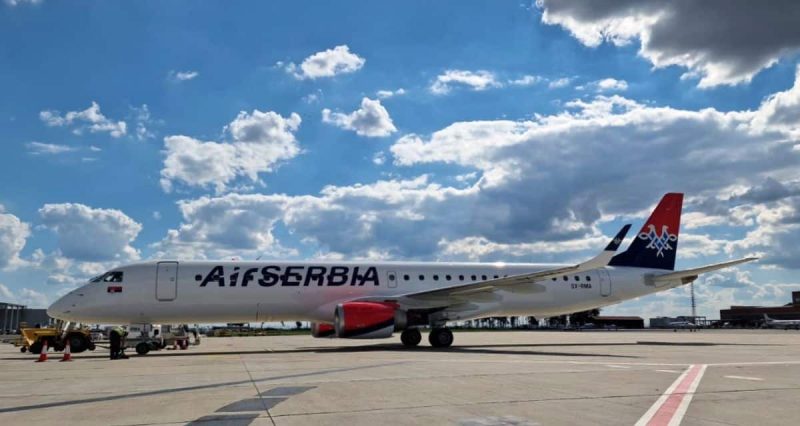The preliminary report of air accident investigators on the incident that occurred on February 22, 2024 with an Embraer 195 operated by Marathon Airlines at Belgrade Airport makes serious accusations against the pilots.
The regional jet with the registration OY-GDC was supposed to be on behalf of Air Serbia fly from the Serbian capital to Düsseldorf under flight number JU324. The aircraft was on runway 30L on taxiway D5, which has an available runway of 1.273 meters. The plane took off at 17:38 p.m. and overshot the end of the runway before becoming airborne. Both the approach lights and the ILS antenna on runway 12R were touched because the Embraer 195 only actually rose into the air about 500 meters after the end of the runway. The aircraft climbed approximately 2.050 m past the end of the runway to an altitude of 15 meters and completed its climb at 1.219 meters.
The evaluation of the radio communication between the pilots and air traffic control showed that the OY-GDC should drive on Runway 30L at the D6 entrance. In fact, we entered D5. The pilots were expressly informed of this error and asked to return and re-enter at point D6. The pilots of the Greek airline then replied that they were very capable of taking off from D5. The release was granted. The controllers told investigators that they observed the takeoff and noticed that a lot of dust had risen and that the climb was noticeably slow.
Crew deemed launch safe
Shortly after takeoff, the crew reported that they had to return immediately because they had hit an object during departure. The tower controller confirmed the request and instructed an aircraft that was already on the runway to clear it. The pilots stated that they had used full take-off thrust and noticed at around 100 knots that the available runway was not sufficient. They decided that taking off would be safer because they assumed that you would be in the air soon anyway.
The crew began raising the plane's nose to try to get airborne. As the plane left the runway, it began to shake and crashed into an object. After the aircraft became airborne, the crew received several reports of problems with various onboard systems. This included the flaps and ventilation. The checklists would then have been processed and a Mayday emergency call would have been made. A low-level flight was carried out at the tower and asked to check whether everything was OK with the landing gear. However, no damage was found.
However, there were problems with the landing flap. After burning excess fuel, one would have landed at a higher speed than usual. The emergency services called as a precaution discovered a fuel leak in the area of the left wing and immediately informed the pilots about it. The engines were shut down and an emergency team ensured that the leak was temporarily sealed.
The passengers could then get out using the stairs. The severe damage was then noticed from outside by the pilots. Due to an immediate order from the Serbian Civil Aviation Authority, the regional jet was towed to a separate area of Belgrade Airport.
Pilots are said to have inadequately assessed flight parameters
During a daylight visual inspection the next morning, tire tracks from the aircraft were found extending beyond the end of the asphalt surface. It was confirmed that the aircraft had collided with several approach lights and the ILS surveillance antenna, which was located 45 meters behind the tarmac. Parts of the airport perimeter fence were found in the wing root of the aircraft itself. Concrete contact marks from the aircraft's fuselage were found on the ground about 160 meters behind. No traces of the aircraft's nose wheels were found on the ground, while traces of the main landing gear were found up to the surveillance antenna.
In the first interim report, Serbian civil aviation accident investigators assume that the Embraer 195, operated by Marathon Airlines, went beyond the end of the runway and the two main landing gear struts carried most of the weight and transmitted the vibrations to the airframe. The aircraft struck the surveillance antenna and its foundation with the left wing. The pilots may have inadequately assessed the take-off parameters during preparation and made the decision to take off on the shortened runway carelessly and thus ignore the controllers' warning.
Air Serbia responded immediately to the incident and The collaboration with Marathon Airlines was terminated without notice. The capacity could be - at least partially - compensate with a Boeing 737-800 from Klasjet. Nevertheless, the Serbian carrier has to shorten the flight schedule. It was originally planned that the wet lease cooperation with Marathon Airlines would be expanded to include two Embraer jets in the summer of 2024.







 trail (for them it's free to use)
trail (for them it's free to use)
2 Comments